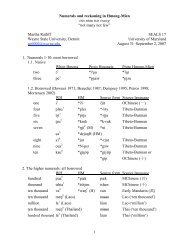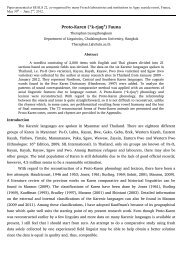proto-southwestern-tai revised: a new reconstruction - seals 22
proto-southwestern-tai revised: a new reconstruction - seals 22
proto-southwestern-tai revised: a new reconstruction - seals 22
You also want an ePaper? Increase the reach of your titles
YUMPU automatically turns print PDFs into web optimized ePapers that Google loves.
A MINIMALIST APPROACH TO<br />
AMIS 1 VOICE MARKERS<br />
Yi-Ting Chen<br />
Arizona State University, Wenzao Ursuline College of Languages<br />
<br />
0 Abstract<br />
This paper relates underlying properties of Amis voice markers to each other in a<br />
Generative approach. This study suggests that the computation of Aktionsart in the head of<br />
the Inner Aspect phrase (InnAspP) is the key to correlate these underlying properties. This<br />
computation not only contributes to the default temporal, aspectual, and modal (TAM)<br />
reading of Amis voice markers but also differentiates undergoer voice markers from<br />
others. This study first assumes that the realization of the feature morpheme is determined<br />
by whether the argument it introduces is raised to the edge. Then agreement takes places,<br />
which explains why the voice marker and the nominative NP are co-indexed.<br />
1 Introduction<br />
1.1 Purpose of the study<br />
The purpose of this study is to use the Generative model to interpret the underlying<br />
properties of Amis voice markers, which have been investigated in many descriptive (e.g.,<br />
T-L. Huang, 1988; Y-J. Huang, 1988; Wu, 2000) and Role and Reference Grammar (RRG)<br />
studies (e.g., Wu, 2005; 2006; 2007). Unlike previous research which has tried to reveal<br />
the entangled complexities of Amis voice markers, this study intends to correlate these<br />
underlying properties from the perspective of Generative Grammar and provide an<br />
interpretation of why they are connected.<br />
1.2 What are voice markers?<br />
Voice systems are commonly found in approximately 60% of western Austronesian<br />
languages (Himmelmann, 2005), a group to which Amis belongs. What are voice markers<br />
in terms of Generative linguistics? Many researchers (e.g., Guilfoyle, Hung, and Travis,<br />
1992 (GHT hereafter); Rackowski, 2002; Chang, 2004; Pearson, 2005) have pursued an<br />
answer to this research question and provided various proposals. This study reviews<br />
several well-known proposals in the following section.<br />
1<br />
Amis, a Formosan language, belongs to the western Austronesian language family. The speaker<br />
population is approximately 172,000, according to the census report by the Council of Indigenous People<br />
in Taiwan in November 2007.<br />
Yi-Ting Chen. 2009. A Minimalist Approach to Amis Voice Markers. Journal of the Southeast Asian<br />
Linguistics Society 2:23-36.<br />
Copyright vested in the author.<br />
23





